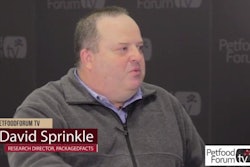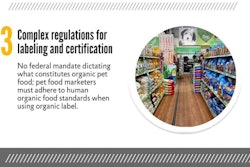As the largest group of pet owners in the US now, millennials spend healthily on pet food, hitting US$3.64 billion in 2015. It makes perfect sense for pet food brands to court these up-and-coming consumers. Yet it’s also wise not to forget that baby boomer pet parents are still driving the highest pet food spending – to the tune of US$15.57 billion in 2015. That’s more than all other generational groups combined.
We have this latest information thanks to John Gibbons of PetBusinessProfessor.com, who compiled and analyzed data from the US Bureau of Labor Statistics. In this case, the data is categorized by consumer units (CU), a term often used interchangeably with households but not quite the same, Gibbons wrote. “A CU indicates independent decision-making on living expenditures. You can have more than one CU in a household: boarders, roommates, etc. As a result, there are a few more CUs than households.”
Not surprisingly, boomers, consumers born from 1946-64, still comprise the largest number of CUs (hence, their name), at 44 million and 34.4 percent of all US CUs. While millennials, born from 1981 to 1997, surpassed baby boomers in the number of individuals in March 2016, they “still have a lot of ground to make up,” Gibbons said, in terms of financially independent CUs. Also not a surprise. They now number 29 million CUs, or 22.6 percent of the total. Of course, the millennial group is increasing the most, adding 1.9 million CUs in 2015.
The other age groups covered in the report include Gen X (born 1965 to 1980, 35.9 million CUs, 27.9 percent of the total), the Silent Generation (born 1929 to 1945, 17.1 million CUs, 13.3 percent) and the Greatest Generation (born before 1929, 2.3 million CUs, 1.8 percent). Again, not surprisingly, the three oldest groups are declining in CUs, with boomers down 0.8 million in 2015, Silents down 0.9 million and Greatests down 0.5 million. Gen X added 1.6 million CUs in 2015.
Boomers spending big on all things pet
Perhaps it should also not be a surprise that boomers dominate pet food and overall pet spending to such a degree, but they do. Besides their sheer number of CUs, this likely has to do with their tendency to have higher incomes. Gibbons detailed all of this on his website, complete with helpful graphs and charts, so I won’t repeat it all here.
But here’s the bottom line: Boomers simply spend a lot more on pet food and other pet supplies and services than any other group. “Not only do they have the biggest piece of the pet industry pie, it is 15 percent larger than number two (Gen X) and number three (millennials) combined,” Gibbons wrote. Their US$32.15 billion spending on pet food, supplies and services represented growth of 9.1 percent over 2014 and accounted for 78.1 percent of the US$3.43 billion increase in overall US pet spending.
Specific to pet food, boomers spent an average of US$355.98 per CU in 2015, up US$139.08 year over year. Their overall US$15.57 billion spent on pet food represented a nearly 60 percent increase, with more of the increase (US$3.44 billion) happening in the second half of the year (versus US$2.39 billion in the first half). Gibbons attributed this to boomers’ decision to upgrade the type of pet food they buy, driving the US’s overall pet food and pet industry spending growth for 2015.
Meanwhile, millennials spent 15 percent less on pet food in 2015 than in 2014, with the decline happening mainly in the second half of 2015. This resulted in an average of US$126.57 per CU spent on pet food, down US$31.95. Older members of this group also upgraded their pet food purchases in 2014, Gibbons said, but then pulled back in 2015, particularly later in the year.
Gen X, with 24 percent more CUs than millennials, spent twice as much on pet food: US$7.26 billion, to be exact, up 3.8 percent from 2014. Gibbons noted, however, that the 2015 increase came solely from a 4.9 percent rise in CUs; the average spent per CU declined slightly (-US$0.44) to US$204.44.
On the other hand, the Silent Generation dropped 4.9 percent in CUs, negating their 7 percent growth in average CU spending on pet food (US$171.57, up US$11.30). Their total pet food spending for 2015 was US$2.91 billion, though that did represent a 1 percent increase over 2014. Finally, the Greatest Generation spent an average of US$54.36 per CU on pet food, down US$16.60, with total spending of US$0.12 billion, a 31.7 percent decline. Sadly, this generation now accounts for only 0.4 percent of overall US pet spending.
Though baby boomers may also be declining in individual numbers and CUs, they still present a powerful consumer force that is likely to keep spending well on pet food for some time. Continuing to market to them while also trying to connect with younger pet parents, particularly millennials, provides a significant challenge, but pet food companies should ignore boomers only at their own peril.

















